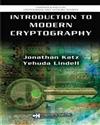| FindBook |
|
有 1 項符合
Jonathan Katz & Yehuda Lindell的圖書 |
 |
$ 1372 ~ 1400 | Introduction to Modern Cryptography: Principles And Protocols
作者:Jonathan Katz & Yehuda Lindell 出版社:全華圖書股份有限公司 出版日期:2007-08-31 語言:繁體書   共 3 筆 → 查價格、看圖書介紹 共 3 筆 → 查價格、看圖書介紹
|
|
|
Cryptography plays a key role in ensuring the privacy and integrity of data and the security of computer networks. Introduction to Modern Cryptography provides a rigorous yet accessible treatment of modern cryptography, with a focus on formal definitions, precise assumptions, and rigorous proofs.The authors introduce the core principles of modern cryptography, including the modern, computational approach to security that overcomes the limitations of perfect secrecy. An extensive treatment of private-key encryption and message authentication follows. The authors also illustrate design principles for block ciphers, such as the Data Encryption Standard (DES) and the Advanced Encryption Standard (AES), and present provably secure constructions of block ciphers from lower-level primitives. The second half of the book focuses on public-key cryptography, beginning with a self-contained introduction to the number theory needed to understand the RSA, Diffie-Hellman, El Gamal, and other cryptosystems. After exploring public-key encryption and digital signatures, the book concludes with a discussion of the random oracle model and its applications.Serving as a textbook, a reference, or for self-study, Introduction to Modern Cryptography presents the necessary tools to fully understand this fascinating subject.
Introduction p. 3
Perfectly-Secret Encryption p. 29
Private-Key (Symmetric) Cryptography p. 45
Private-Key Encryption and Pseudorandomness p. 47
Message Authentication Codes and Collision-Resistant Hash Functions p. 111
Practical Constructions of Pseudorandom Permutations (Block Ciphers) p. 159
Theoretical Constructions of Pseudorandom Objects p. 193
Public-Key (Asymmetric) Cryptography p. 241
Number Theory and Cryptographic Hardness Assumptions p. 24...
- 作者: Jonathan Katz & Yehuda Lindell
- 出版社: 全華圖書股份有限公司 出版日期:2007-08-31 ISBN/ISSN:1584885513
- 語言:繁體中文 裝訂方式:精裝 頁數:552頁
- 類別: 中文書> 科學> 應用科學
|











